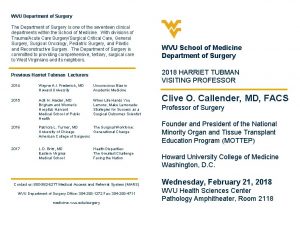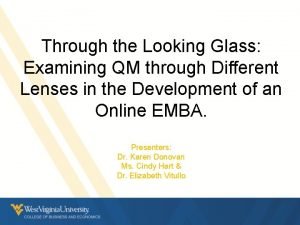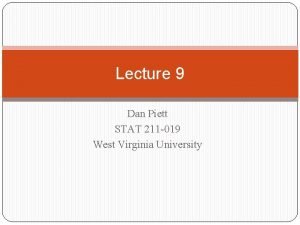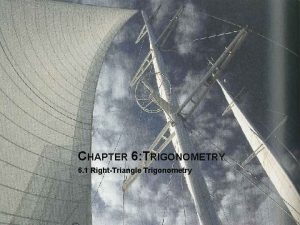Trigonometry Overview tom h wilsongeo wvu edu Department


















- Slides: 18

Trigonometry Overview tom. h. wilson@geo. wvu. edu Department of Geology and Geography West Virginia University Morgantown, WV

Examine the map and measure the distances from the church to the transmitter. If from an exposure, the church is seen to be located 45 o west of north whilst the transmitter is due west, where is the exposure? How far is the exposure from the church and how far from the transmitter?

Given the outcrop width of 1. 25 kilometers for this massive sand which dips northwest at 36 o… . . what is the true (bed normal) thickness of the sand?

IN-CLASS PROBLEMS 1. At the base of a cliff you are standing on top of geological Unit A. The cliff face is formed along a normal fault (nearly vertical). The top of Unit A is also exposed at the top of the cliff face. You walk a distance x = 200 feet away from the fault scarp. Looking back toward the cliff, you use your Brunton and measure and note that the top of the cliff is 23 o above the horizon. What is the offset along this fault? h x Cliff Face

A group trekking through the Himalayas quickly gets lost having forgotten their top maps. They did bring their radio transmitter though. How can they help searchers determine their location? Assume they have a digital altimeter/barometer and all-purpose Brunton compass.

2. In the example illustrated below, a stream erodes less resistant fault gauge leaving an exposed fault scarp on the distant bank. You are unable to traverse the stream or make your way to the top of the exposure. Using your Brunton compass, you stand on the left edge of the stream and measure the angle (a) formed by the top of the cliff and the horizontal. You walk to the left 175 feet and measure angle (b). Angle a measure 31 o and angle b, 19 o. How can you determine the cliff height? What is the width of the stream? h b d a Stream Fault Scarp

4. The three point problem uses elevations measured at three points on a stratigraphic surface to determine the strike and dip of that surface. The elevations and locations of these points can be measured at the surface or, more likely, in the borehole. In the following problem, you have data from three boreholes (located in the map below) indicating subsea depths to the top of the Oriskany Sandstone as shown. -4700’ N -4300’ -5000’ Scale: 1: 1000

The following figures were taken from http: //courses. geo. ucalgary. ca/glgy 201/12 steps 1. htm; visit this site for a more comprehensive overview of the three-point problem

http: //courses. geo. ucalgary. ca/glgy 201/12 steps 1. htm

http: //courses. geo. ucalgary. ca/glgy 201/12 steps 1. htm

Now, how can you determine the dip? 300 feet 2080 feet Measure length of line 3. Given this length and the drop in elevation you can figure the dip directly -

B c A a C b 1. The 180 o rule 2. 3. Sine rule Cosine rule

Triangles which do not contain a right angle



Question: Does the vector sum of C and D equal B? If not, how has velocity changed? What geological processes are accommodated by this change.


 Wvu department of surgery
Wvu department of surgery Math department wvu
Math department wvu Cos sin tan tabell
Cos sin tan tabell Department overview template
Department overview template Tom tom go 910
Tom tom go 910 Symbols in the devil and tom walker
Symbols in the devil and tom walker Edu.sharif.edu
Edu.sharif.edu Degreeworks wvu
Degreeworks wvu Cs101 wvu
Cs101 wvu Math 150 wvu
Math 150 wvu Wvu emba
Wvu emba Wvu research office
Wvu research office Wvu stat 211
Wvu stat 211 John quaranta wvu
John quaranta wvu Degree works wvu
Degree works wvu Symplicity wvu law
Symplicity wvu law Wvu student legal services
Wvu student legal services Wvu oit
Wvu oit Wvu oit
Wvu oit

































